
The war years bring a new light to beachfront activities, as the importance of the Pacific Campaign places a new emphasis upon the maritime activities of the Japanese as the target for Allied counter-attack. Into the world of beaches spring such items as invasion landing craft and observation outposts, all of which become fully exploited by the animation industry in their ever-present output of propaganda-laced morale boosters and troop films. A few of these will be encountered in today’s offerings, including what little is known about a few titles seemingly lost to time. Plus, the usual stock of recreational outings, shipwrecks, and even a chance for some genuine jazz played on the sands.
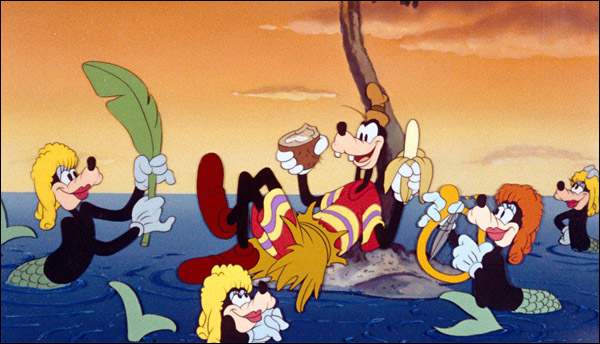
How To Swim (Disney/RKO, Goofy, 10/23/42 – Jack Kinney, dir.) – A typical – yet typically funny – outing in Kinney’s mock sports-instructional series of Goofy shorts, with narrator John McLeish providing the usual stoic yet constantly frustrated background lecture in vain attempt to justify what Goofy is doing. This installment begins in the comfort of one’s own living room, with the Goof (dressed in the same bathing suit he had left over from “Hawaiian Holiday”) demonstrating the unique approach of learning the basic strokes of swimming while resting his belly atop a piano stool. What Goof fails to realize is that somehow, his simulated strokes through nothing but air are propelling the wheeled stool to move along through the room as if he were really swimming – causing the device with Goof aboard to roll out the front door, into the street, and across a line of frustrated motorists attempting to avert a collision. Goof someghow reverses course, returning back through his front door, across the living room, and rolling into his bathroom – where he nearly drowns by falling into the bathtub.
 Act two brings the Goof to the seashore to “try his wings”. His first challenge is to remove his street clothes in an extremely narrow beach locker. The tall lanky Goof nearly fills up the locker’s available space completely, and his efforts to change outfits literally turn him upside down. The locker begins to wobble, knocking down all the other adjoining lockers like a row of dominoes – then, Goof’s locker waddles its way down the pier, and off the end, sinking into the bay below. When Goofy finally emerges, he has no idea that his locale has changed from dry to wet, and steps forward encased in the bubble of air he has carried with him inside the locker, never noticing that there is water everywhere outside its perimeter. Carrying a beach umbrells, beach chair, and picnic lunch, Goofy sets up camp as if he were still on the shore, planting the umbrella point in the bottom soil of the bay – again never realizing that he has punctured the bottom of the bubble in the process. As water seeps in through the hole, the lower half of the bubble begins to disappear from the screen, blending with the water around it. Goof nevertheless remains totally unaware, and begins consuming his picnic lunch. The narrator stresses the important rule that one should not go in swimming until at least an hour after eating, or you might end up with cramps. The Goof isn’t going to have the luxury of such a wait, with his bubble about to disappear entirely, and of course ends up fully submerged just as he downs his last chicken drumstick. Drifting up to the surface, Goof’s limbs literally twist into double and triple rows of knots. Even his neck, both ears and face twist into similar contortions. The narrator stresses to lie perfectly still, remembering that the body is lighter than water, so can’r possibly sink. Says you. Goofy comes out of the knots, but his arms and legs stretch his suit to full extension, making it appear like the masts and hull of a battleship – then, remaining in such rigid pose, he tips sideways, and slips bow first back into the ocean depths, to the tune of “Rocked in the Cradle of the Deep.”
Act two brings the Goof to the seashore to “try his wings”. His first challenge is to remove his street clothes in an extremely narrow beach locker. The tall lanky Goof nearly fills up the locker’s available space completely, and his efforts to change outfits literally turn him upside down. The locker begins to wobble, knocking down all the other adjoining lockers like a row of dominoes – then, Goof’s locker waddles its way down the pier, and off the end, sinking into the bay below. When Goofy finally emerges, he has no idea that his locale has changed from dry to wet, and steps forward encased in the bubble of air he has carried with him inside the locker, never noticing that there is water everywhere outside its perimeter. Carrying a beach umbrells, beach chair, and picnic lunch, Goofy sets up camp as if he were still on the shore, planting the umbrella point in the bottom soil of the bay – again never realizing that he has punctured the bottom of the bubble in the process. As water seeps in through the hole, the lower half of the bubble begins to disappear from the screen, blending with the water around it. Goof nevertheless remains totally unaware, and begins consuming his picnic lunch. The narrator stresses the important rule that one should not go in swimming until at least an hour after eating, or you might end up with cramps. The Goof isn’t going to have the luxury of such a wait, with his bubble about to disappear entirely, and of course ends up fully submerged just as he downs his last chicken drumstick. Drifting up to the surface, Goof’s limbs literally twist into double and triple rows of knots. Even his neck, both ears and face twist into similar contortions. The narrator stresses to lie perfectly still, remembering that the body is lighter than water, so can’r possibly sink. Says you. Goofy comes out of the knots, but his arms and legs stretch his suit to full extension, making it appear like the masts and hull of a battleship – then, remaining in such rigid pose, he tips sideways, and slips bow first back into the ocean depths, to the tune of “Rocked in the Cradle of the Deep.”
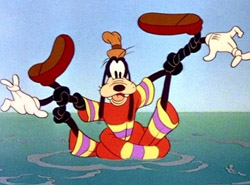 Act 3 places the Goof into a demonstration of diving. A bare outline in white of an idealized diver serves as the “chart” to exhibit how it should be done. Then Goofy is combined on the same diving board with the “chart”, in attempt to copy its grace and style. The slow motion camera is employed in a favorite gimmick of the Kinney cartoons, as Goof and the chart approach the end of the board in perfect unison – for three steps, anyway. Then Goofy gets his big feet caught up in the edge of the rubber surrounding the platform end of the board, and falls forward. Instead of launching itself off the board’s end, the chart propels itself off the end of Goofy’s nose. The Goof himself is bounced into the air, coming down headfirst upon the board, launching him into a series of multiple bounces. He performs slow motion cartwheels, loses his bathing suit entirely, struggles to put it back on, then finally tips his hat as he clears the end of the board, to sail gracefully into the pool – which he has forgotten to fill with water, thus leaving his silhouette jaggedly punctured into the tiles of the pool flooring.
Act 3 places the Goof into a demonstration of diving. A bare outline in white of an idealized diver serves as the “chart” to exhibit how it should be done. Then Goofy is combined on the same diving board with the “chart”, in attempt to copy its grace and style. The slow motion camera is employed in a favorite gimmick of the Kinney cartoons, as Goof and the chart approach the end of the board in perfect unison – for three steps, anyway. Then Goofy gets his big feet caught up in the edge of the rubber surrounding the platform end of the board, and falls forward. Instead of launching itself off the board’s end, the chart propels itself off the end of Goofy’s nose. The Goof himself is bounced into the air, coming down headfirst upon the board, launching him into a series of multiple bounces. He performs slow motion cartwheels, loses his bathing suit entirely, struggles to put it back on, then finally tips his hat as he clears the end of the board, to sail gracefully into the pool – which he has forgotten to fill with water, thus leaving his silhouette jaggedly punctured into the tiles of the pool flooring.
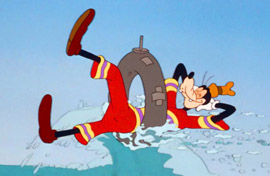 The final act brings us a close resemblance to a sequence from “Hawaiian Holiday”, as Goof attempts to launch himself into the surg, wearing an old innertube around his waist. The oncoming surf tosses him back onto the land, with the innertube making contact with the pointed end of a half-buried sea anchor. (You notice how no one ever cleans up these cartoon beaches of old leftover nautical hardware?) The innertube punctures, sending Goofy rolling over the sand with the sounds of a flat tire. With the floatation device deflated, the wave attacks again, driving Goof and the innertube back up the beach, where the rubber tubing gets caught on two wooden pilings, with Goofy inbetween. The wave continues to push Goofy until he is loaded into the tubing like a rock in a slingshot – then the wade recedes, leaving the Goof to be propelled into the ocean, where he skips over the water like a stone, far out to sea, and comes to rest on a tiny tropical island. The isle turns out to be not a bad place to be, as it is surrounded by a harem of Goof-faced mermaids, who play serenades to Goofy on their lyres, fan him with palm leaves, and feed him bananas and cocoanut milk – enough justification for the narrator to conclude that everyone should learn how to swim.
The final act brings us a close resemblance to a sequence from “Hawaiian Holiday”, as Goof attempts to launch himself into the surg, wearing an old innertube around his waist. The oncoming surf tosses him back onto the land, with the innertube making contact with the pointed end of a half-buried sea anchor. (You notice how no one ever cleans up these cartoon beaches of old leftover nautical hardware?) The innertube punctures, sending Goofy rolling over the sand with the sounds of a flat tire. With the floatation device deflated, the wave attacks again, driving Goof and the innertube back up the beach, where the rubber tubing gets caught on two wooden pilings, with Goofy inbetween. The wave continues to push Goofy until he is loaded into the tubing like a rock in a slingshot – then the wade recedes, leaving the Goof to be propelled into the ocean, where he skips over the water like a stone, far out to sea, and comes to rest on a tiny tropical island. The isle turns out to be not a bad place to be, as it is surrounded by a harem of Goof-faced mermaids, who play serenades to Goofy on their lyres, fan him with palm leaves, and feed him bananas and cocoanut milk – enough justification for the narrator to conclude that everyone should learn how to swim.
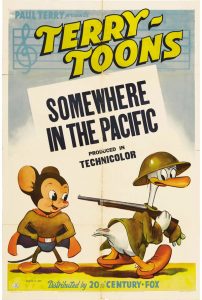 There are a couple of “lost” Terrytoons, titles and a few surviving backgrounds which suggest beachfron action during the wartime. “The Outpost” (Terrytoons/Fox, Gandy Goose and Sourpuss, 7/10/42 – Mannie Davis., dir.) is at least one someone claims to have seen (though perhaps the information is sourced from trades of the day). A synopsis appears on IMDB, reading as follows:
There are a couple of “lost” Terrytoons, titles and a few surviving backgrounds which suggest beachfron action during the wartime. “The Outpost” (Terrytoons/Fox, Gandy Goose and Sourpuss, 7/10/42 – Mannie Davis., dir.) is at least one someone claims to have seen (though perhaps the information is sourced from trades of the day). A synopsis appears on IMDB, reading as follows:
“Gandy Goose and Sourpuss, in army uniforms, man a far pacific advance station themselves. This day, Japanese planes try to bomb them, and are shot down. Then, sighting an enemy battleship, and itching for action, they jump into a PT boat to catch it. They climb up the anchor chain and board her. The Japanese sailors are large, fat pigs. Guns blazing, they chase Gandy and Sourpuss around the deck, and they shoot and chase them too. Many are tricked into putting their heads into a porthole and getting knocked silly, falling off the side. Another sailor is fooled by Gandy using cartridges for teeth and squinting his eyes into thinking he’s another Japanese. Their leader, a full-dress Admiral, is stuffed into an anti-aircraft gun with a bar of soap, shot out in a soap bubble, then brought down with a slingshot. The Admiral takes off for our heroes with a barrel of gun powder, not realizing Sourpuss has set it alight. The boys escape as the battleship explodes.”
Also unaccounted for is “Somewhere in the Pacific” (Terrytoons/Fox, 12/25/42 – Mannie Davis, dir.), for which production backgrounds have appeared at auction depicting a tiny tropical island. Another background located by Heritage Auctions depicts a nasty-looking sterotype-faced Japanese carrier, looking like it is about to go down for the third time (proof enough why this film is never shown). Unfortunately, this film is so lost, no review of it appears on IMDB. Any information from trades (if any exist) would be welcome.
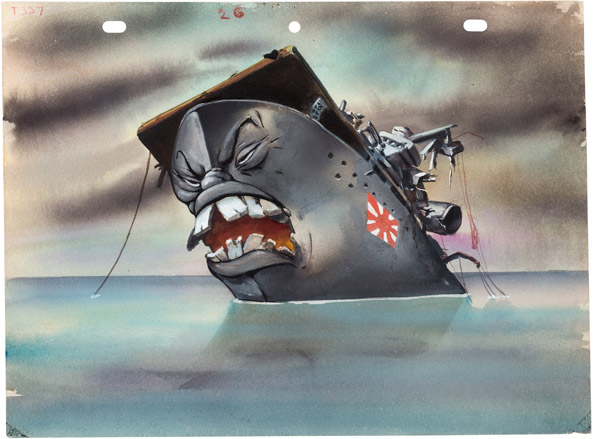
 Wakiki Wabbit (Warner, Bugs Bunny, 7/3/43 – Charles M. (Chuck Jones, dir.), has been briefly visited long ago in this column, during our early study of cannibalism among non-cannibals, “Unhealthy Appetites”. It is one of the ealiest instances of food-deprived white men becoming so hallucinatory as to envision each other as food, and so ravenous as to carry the illusion through to its logical consequences. Two shipwrecked sailors in a stylistically sparse two-tone sea float together on a raft, eyeing each other as food. The taller sailor sees the fat sailor as a giant hamburger, and in carton tradition asks that someone “hold the onions”. “Huh, what’d you say?” says the fat one, jarring the tall sailor back to reality. After a time, the fat sailor eyes the leg of his companion like a juicy drumstick, and begins to sprinkle salt on it – until caught in the act, at which he retreats back to his side of the raft. Things get so desperate, the tall sailor starts eying his own foot as a dinner prospect, placing same on a plate. His fat partner observes this and dons a bib, with knife and fork, hoping to get in on the free meal – but the tall sailor snatches his own foot away possessively, clutching it in his arms as if to say, “This is mine.” Fortunately, these perils go no further, as an equally stylized island (consisting of wild splashes of background color and using wallpaper-like patterns as simulation for jungle undergrowth) looms on the horizon, When the sailors arrive, they encounter the island’s sole inhabitant – Bugs Bunny, who gives them a friendly greeting, “What’s the good word, strangers?” The two sailors respond in unison with the “good word” – “FOOD!” Bugs quickly realizes he is on the spot, and makes a retreat between the trees.
Wakiki Wabbit (Warner, Bugs Bunny, 7/3/43 – Charles M. (Chuck Jones, dir.), has been briefly visited long ago in this column, during our early study of cannibalism among non-cannibals, “Unhealthy Appetites”. It is one of the ealiest instances of food-deprived white men becoming so hallucinatory as to envision each other as food, and so ravenous as to carry the illusion through to its logical consequences. Two shipwrecked sailors in a stylistically sparse two-tone sea float together on a raft, eyeing each other as food. The taller sailor sees the fat sailor as a giant hamburger, and in carton tradition asks that someone “hold the onions”. “Huh, what’d you say?” says the fat one, jarring the tall sailor back to reality. After a time, the fat sailor eyes the leg of his companion like a juicy drumstick, and begins to sprinkle salt on it – until caught in the act, at which he retreats back to his side of the raft. Things get so desperate, the tall sailor starts eying his own foot as a dinner prospect, placing same on a plate. His fat partner observes this and dons a bib, with knife and fork, hoping to get in on the free meal – but the tall sailor snatches his own foot away possessively, clutching it in his arms as if to say, “This is mine.” Fortunately, these perils go no further, as an equally stylized island (consisting of wild splashes of background color and using wallpaper-like patterns as simulation for jungle undergrowth) looms on the horizon, When the sailors arrive, they encounter the island’s sole inhabitant – Bugs Bunny, who gives them a friendly greeting, “What’s the good word, strangers?” The two sailors respond in unison with the “good word” – “FOOD!” Bugs quickly realizes he is on the spot, and makes a retreat between the trees.
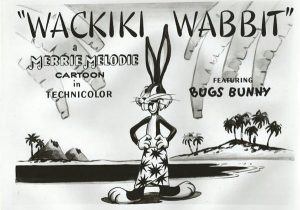 The sailors pursue, coming into a clearing, where they find Bugs again, now dressed in a sarong, disguising himself as an islander, and dancing a tropical dance. “Ah. White men.”, he reacts, and begins talking in a mumbo-jumbo mock island dialect, that can only be understood by the audience through the use of onscreen subtitles. A longwinded series of doubletalk babbling produces a simple subcaption: “What’s up, Doc?”, while a mere grunt from Bugs produces the subtitle, :Now is the time for every good man to come to the aid of his party.” “Well, thanks,” responds the tall sailor. A subtite flashes on the screen reading “Ofa eno maua te ofe popaa.” The fat sailor, able to see this lettering, asks his partner, “Gee, did you say that?” Bugs breaks into his dance again, audibly accompanied by an unseen tom tom player and singing native chanter (who are never revealed, and subsequently disappear from hearing as quickly as they came). The two gullble sailors join in the mood by imitating Bugs’ steps, until Bugs abruptly breaks off his performance and merely walks away, pointing over gis shoulder at the castaways as if to sarcastically say, “Get them.” The fat sailor keeps right on dancing, until the tall one realizes they are now quite alone, and slaps the face of his partner to wake him up to their having been duped.
The sailors pursue, coming into a clearing, where they find Bugs again, now dressed in a sarong, disguising himself as an islander, and dancing a tropical dance. “Ah. White men.”, he reacts, and begins talking in a mumbo-jumbo mock island dialect, that can only be understood by the audience through the use of onscreen subtitles. A longwinded series of doubletalk babbling produces a simple subcaption: “What’s up, Doc?”, while a mere grunt from Bugs produces the subtitle, :Now is the time for every good man to come to the aid of his party.” “Well, thanks,” responds the tall sailor. A subtite flashes on the screen reading “Ofa eno maua te ofe popaa.” The fat sailor, able to see this lettering, asks his partner, “Gee, did you say that?” Bugs breaks into his dance again, audibly accompanied by an unseen tom tom player and singing native chanter (who are never revealed, and subsequently disappear from hearing as quickly as they came). The two gullble sailors join in the mood by imitating Bugs’ steps, until Bugs abruptly breaks off his performance and merely walks away, pointing over gis shoulder at the castaways as if to sarcastically say, “Get them.” The fat sailor keeps right on dancing, until the tall one realizes they are now quite alone, and slaps the face of his partner to wake him up to their having been duped.
After a fade, we observe the sailors reading a book on native customs, open to a page about natives being skilled at diving for coins thrown in the water. The sailors have their own idea for this trick, and flip a coin into a water-filled cooking pot, expecting Bugs to dive in. Bugs appears on cue, but snatches the whole pot away before the fat sailor can slam down the lid, causing him to bring the lid crashing sown on the head of his partner. A few moments later, the sailors catch up with Bugs. To their surprise, they find that Bugs has voluntarily assumed a position inside the cooking pot, treating it as a bathtub (revisiting a situation which became a Bugs’ trademark, first appearing in “Hiawatha’s Rabbit Hunt” (1941)). Realizing their dinner is cooking itself, the sailors produce from nowhere a restaurant table and chair, setting up the tall sailor as dining patron, while the fat one plays chef, delivering a menu with one item on it – “Rabbit”. The chef ckecks on the simmering Bugs, ladling hot water over his head. Bugs cooperates, shifting positions. “The back, please, the back”, he askes, as the sailor ladles on another spoon full of water.
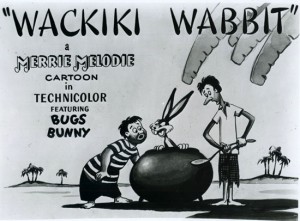 The sailors begin to get excited, chanting in sing-song fashion, “We’re gonna have roast rabbit.” (Roast? Isn’t it more like boiled?) Bugs begins to join in the song – then realizes what he is saying. In a zip-blur, he retreats to a treehouse in a tall palm tree. There he rigs up a substitute for himself in the pot – a roast chicken, tied like a puppet to marionette strings. The bird is lowered into the water, just as the fat sailor enters with a serving dish, and scoops his culinary masterpiece out of the water for the feast. The bird (which neither sailor notices is of a different species than the meal they started with) is placed on the table, and the tall sailor prepaes to carve – when the bird rises from the plate, snatching away the sailor’s utensil. “No ya don’t” saus the offscreen voice of Bugs from above, as he manipulates the strings to have the bird advance on the sailors. “Pull a knife on me, would ya?” The bird threatens the sailors with “One false move and I’ll….”, making a slashing motion across the bird’s already decapitated throat. As the bird turns away, it begins to stumble – then whirls around in a complete change of demeanor, beckoning the sailors with one wing, then pointing up into the tree with the other. The reason? Bugs has snarled the marionette strings, and struggles to untangle them, putting the bird into movements unplaned by its puppeteer that inadvertently give him away. The sailors grab hold of the strings, and yank Bugs down out of the tree. They pounce on Bugs, but as the dust clears, they find themselves only clinging to the chicken. Oh, well, at least it’s meat. That is, until Bugs gives a final yank on the strings from behind a tree, pulling all the meat off the chicken’s bones, leaving only a skeleton. The desperate sailors lose it, and break into a helpless crying jag. Theit wailing is suddenly interrupted by a loud steam whistle, as an ocean liner uexpectedly steams into the bay. The sailors forget all thoughts of Bugs, and rejoice, “A ship”, then resume their sing song with new lyrics, “We’re going on a boat.” Bugs appears among them, throwing flower leis around their necks, and bringing them two packed travel suitcases. “Bon voyage. Don’t forget to write”, Bugs cheerfully repeats over and over, catching the sailors up in his festive mood – but gradually managing to switch position, so that he winds up carrying the suitcases, with the flower leis around his neck. At a full sized dock which magically appears from nowhere, the ship lowers its gangplank, and Bugs mounts the ramp backwards, boarding the ship nd leaving his visitors waving farewells from the dock. The ship sets sail, and disappears over the horizon, before either sailor can figure out quite what hit them. The fat sailor soon learns what hit him, as the hand of the tall sailor snaps him back to reality again. Now, with no prospect of escaping, and their only supply of live protein hone, there is just one thing left for the sailors to do – envision each other as a hamburger and hot dog, and chase each other round and round the beach for the iris out.
The sailors begin to get excited, chanting in sing-song fashion, “We’re gonna have roast rabbit.” (Roast? Isn’t it more like boiled?) Bugs begins to join in the song – then realizes what he is saying. In a zip-blur, he retreats to a treehouse in a tall palm tree. There he rigs up a substitute for himself in the pot – a roast chicken, tied like a puppet to marionette strings. The bird is lowered into the water, just as the fat sailor enters with a serving dish, and scoops his culinary masterpiece out of the water for the feast. The bird (which neither sailor notices is of a different species than the meal they started with) is placed on the table, and the tall sailor prepaes to carve – when the bird rises from the plate, snatching away the sailor’s utensil. “No ya don’t” saus the offscreen voice of Bugs from above, as he manipulates the strings to have the bird advance on the sailors. “Pull a knife on me, would ya?” The bird threatens the sailors with “One false move and I’ll….”, making a slashing motion across the bird’s already decapitated throat. As the bird turns away, it begins to stumble – then whirls around in a complete change of demeanor, beckoning the sailors with one wing, then pointing up into the tree with the other. The reason? Bugs has snarled the marionette strings, and struggles to untangle them, putting the bird into movements unplaned by its puppeteer that inadvertently give him away. The sailors grab hold of the strings, and yank Bugs down out of the tree. They pounce on Bugs, but as the dust clears, they find themselves only clinging to the chicken. Oh, well, at least it’s meat. That is, until Bugs gives a final yank on the strings from behind a tree, pulling all the meat off the chicken’s bones, leaving only a skeleton. The desperate sailors lose it, and break into a helpless crying jag. Theit wailing is suddenly interrupted by a loud steam whistle, as an ocean liner uexpectedly steams into the bay. The sailors forget all thoughts of Bugs, and rejoice, “A ship”, then resume their sing song with new lyrics, “We’re going on a boat.” Bugs appears among them, throwing flower leis around their necks, and bringing them two packed travel suitcases. “Bon voyage. Don’t forget to write”, Bugs cheerfully repeats over and over, catching the sailors up in his festive mood – but gradually managing to switch position, so that he winds up carrying the suitcases, with the flower leis around his neck. At a full sized dock which magically appears from nowhere, the ship lowers its gangplank, and Bugs mounts the ramp backwards, boarding the ship nd leaving his visitors waving farewells from the dock. The ship sets sail, and disappears over the horizon, before either sailor can figure out quite what hit them. The fat sailor soon learns what hit him, as the hand of the tall sailor snaps him back to reality again. Now, with no prospect of escaping, and their only supply of live protein hone, there is just one thing left for the sailors to do – envision each other as a hamburger and hot dog, and chase each other round and round the beach for the iris out.
Bugs Bunny Nips the Nips (Warner, Bugs Bunny, 4/22/44, I. (Friz) Freleng, dir.) – Warning for the faint-hearted. This is perhaps the most offensive cartoon in which Bugs Bunny was ever featured, and, despite some moments of clever humor, contains many scenes that are to modern eyes decidedly unfunny and downright painful to watch. Nevertheless, we present its coverage here in out unflinching dedication to historical completeness, and to present an accurate picture of where American popular culture and the government propaganda machine were in mindset at the time.
 Somewhere in the pacific, we find a floating crate fallen off some passing ship, and hear the vocal strains of “Someone’s Rocking My Dreamboat” coming from within. The crate’s passenger is Bugs (who we have to feel a little sorry for, as the crate is built so claustrophobically, Bugs’ ears don’t even fit inside, and have to protrude through gaps in the wooden slats above. Nevertheless, Bugs takes it in stride, and informs the audience, “Just killin’ time until the inevitable island that turns up in these kind of pictures inevitably turns up.” Before we know it, Bugs’ prediction is proven true, as an island is sighted. Bugs sticks his arms and legs out the crate as if he were in a turtle shell, and swims his way to shore. We never see how he extricates himself from the wooden prison once on land, but somehow he is free to admire his surroudings. “What a beautious garden of Eden. A veritable Shanhri-La of flagrant beauty. A lustrous poil of the Pacific. So peaceful. So quiet…..” The thought is never finished, as the sounds of artillery fire fill the air. Bugs dives for cover, into an unexplained prop one would never expect to find on a desert island – a haystack. As Bugs’s head protrudes from the hay to see if the ciast is clear, the hay below him begins to move, sprouting uniformed arms and legs. One hand places a military cap atop the haystack, landing on Bugs’ brow instead of the owner’s. The stranger below lifts up the stack, takes a few steps forward – then suddenly realizes he cannot feel his hat. The hand emerges again, holding up a mirror to see whose face is in the top of the stack. Bugs smiles a sheepish grin into the looking glass, which disappears into the hay, quickly replaced by the face of the other occupant – a Japanese soldier. Though it becomes evident the soldier knows some English, he at first speaks in Mel Blanc’s unintelligible Oriental-flavored gibberish, taking swipes at Bugs with a large sword. Bugs leaps into a hole in the ground (convenient, since he bever had time to dig one himself.).
Somewhere in the pacific, we find a floating crate fallen off some passing ship, and hear the vocal strains of “Someone’s Rocking My Dreamboat” coming from within. The crate’s passenger is Bugs (who we have to feel a little sorry for, as the crate is built so claustrophobically, Bugs’ ears don’t even fit inside, and have to protrude through gaps in the wooden slats above. Nevertheless, Bugs takes it in stride, and informs the audience, “Just killin’ time until the inevitable island that turns up in these kind of pictures inevitably turns up.” Before we know it, Bugs’ prediction is proven true, as an island is sighted. Bugs sticks his arms and legs out the crate as if he were in a turtle shell, and swims his way to shore. We never see how he extricates himself from the wooden prison once on land, but somehow he is free to admire his surroudings. “What a beautious garden of Eden. A veritable Shanhri-La of flagrant beauty. A lustrous poil of the Pacific. So peaceful. So quiet…..” The thought is never finished, as the sounds of artillery fire fill the air. Bugs dives for cover, into an unexplained prop one would never expect to find on a desert island – a haystack. As Bugs’s head protrudes from the hay to see if the ciast is clear, the hay below him begins to move, sprouting uniformed arms and legs. One hand places a military cap atop the haystack, landing on Bugs’ brow instead of the owner’s. The stranger below lifts up the stack, takes a few steps forward – then suddenly realizes he cannot feel his hat. The hand emerges again, holding up a mirror to see whose face is in the top of the stack. Bugs smiles a sheepish grin into the looking glass, which disappears into the hay, quickly replaced by the face of the other occupant – a Japanese soldier. Though it becomes evident the soldier knows some English, he at first speaks in Mel Blanc’s unintelligible Oriental-flavored gibberish, taking swipes at Bugs with a large sword. Bugs leaps into a hole in the ground (convenient, since he bever had time to dig one himself.).
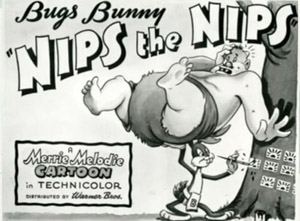 The soldier lights a cartoon bomb and drops it down the hole, then fills the hole with a high pile of sand, sitting upon it to pack it solid. The ground vibrates with the force of a muffled impact from below, then the soldier removes the samd to retrieve his victim. To his surprise, Bugs pops out untouched, still carrying the unexploded bomb, somehow having faked the simulated explosion from below, and hands the bomb to the soldier just in time for the explosion. The soldier resorts to his sword again, aiming for the rabbit ear tips still protruding from the hole. But his attack is brought to a screeching stop, as Bugs elevates from the hole, dressed in the outfit of a Japanese general. “Yipe!”, reacts the soldier in Jack Benny fashion, then apologizes for “regrettable incident”, and informs the “general” that he “not want to make Hari Kari”. The apology is cut short, as dawn breaks in the soldier’s mental recollection. “Honorable ah ha! That are not Japanses general. That are Bugs Bunny. I are see in Reon Schlesiger Merrie Melodies cartoon picture.” The soldier suddenly produces a carrot, and imitates Bugs’s trademark chewing, asking the rabbit, “What are up, honorable Doc?” Knowing the jig is up, Bugs responds, “Honoable Yipe!” Bugs dashes to a nearby airfield, and commandeers a zero fighter. The soldier hops into a second zero, taking off after him – but Bugs has already landed his plane behind the soldier, and also had time to tether the second plane’s tail to a strong palm tree with a rope. As the plane reaches rope’s end, its fuselage is pulled off, leaving the soldier sailing through the sky with only the pilot’s seat and cockpit glass. (Same gag used in Chuck Jones’ “Super Rabbit: (1943).) The soldier bails out in a parachute, drifting over the Pacific. In an impossible feat of flying, Bugs rejoins the soldier in mid air with his own zero, hovering the plane motionless beside the descending soldier, and hands him a heavy anvil. “Here’s some scrap iron for Japan, Moto” (reference to Peter Lorre’s “Mr. Moto” film series for Fox). The soldier falls, presumably to his oblivion, as Bugs shouts, “Happy landing.”
The soldier lights a cartoon bomb and drops it down the hole, then fills the hole with a high pile of sand, sitting upon it to pack it solid. The ground vibrates with the force of a muffled impact from below, then the soldier removes the samd to retrieve his victim. To his surprise, Bugs pops out untouched, still carrying the unexploded bomb, somehow having faked the simulated explosion from below, and hands the bomb to the soldier just in time for the explosion. The soldier resorts to his sword again, aiming for the rabbit ear tips still protruding from the hole. But his attack is brought to a screeching stop, as Bugs elevates from the hole, dressed in the outfit of a Japanese general. “Yipe!”, reacts the soldier in Jack Benny fashion, then apologizes for “regrettable incident”, and informs the “general” that he “not want to make Hari Kari”. The apology is cut short, as dawn breaks in the soldier’s mental recollection. “Honorable ah ha! That are not Japanses general. That are Bugs Bunny. I are see in Reon Schlesiger Merrie Melodies cartoon picture.” The soldier suddenly produces a carrot, and imitates Bugs’s trademark chewing, asking the rabbit, “What are up, honorable Doc?” Knowing the jig is up, Bugs responds, “Honoable Yipe!” Bugs dashes to a nearby airfield, and commandeers a zero fighter. The soldier hops into a second zero, taking off after him – but Bugs has already landed his plane behind the soldier, and also had time to tether the second plane’s tail to a strong palm tree with a rope. As the plane reaches rope’s end, its fuselage is pulled off, leaving the soldier sailing through the sky with only the pilot’s seat and cockpit glass. (Same gag used in Chuck Jones’ “Super Rabbit: (1943).) The soldier bails out in a parachute, drifting over the Pacific. In an impossible feat of flying, Bugs rejoins the soldier in mid air with his own zero, hovering the plane motionless beside the descending soldier, and hands him a heavy anvil. “Here’s some scrap iron for Japan, Moto” (reference to Peter Lorre’s “Mr. Moto” film series for Fox). The soldier falls, presumably to his oblivion, as Bugs shouts, “Happy landing.”
 Having access to a plane, wouldn’t you think Bugs would fly himself out of this situation? No. Instead, he returns to the island’s beach, and paints a Japanese flag insignia on a tree trunk to indicate his first confirmed casualty, in the maner of a fighter pilot on a plane. He walks away a few steps, and encounters a new, more formidable adversary – a Sumo wrestler. Assuming this will still be a snap for him, Bugs returns to the tree, and paints in advance a very large, second Japanese flag insignia, then marches forward to do battle with his foe. The two combatants square off in formal circling fashion, then lunge. In a split second, the wrestler has Bugs tied in the shape of a pretzel (Wouldn’t this have been more appropriate for the Germans?) The Sumo produces a rag from nowhere, ans wipes away the large insignia from the tree. However, the ever-resourceful Bugs frees himself from the knots off camera, and reappears in the full disguise of an Oriental geisha. Muttering more gibberish in effeminate tones, he flirts with the Sumo, inviting him to receive a little kiss. The Sumo bashfully puckers his lips, and lowers his head to Bugs’ behind a concealing Oriental fan. However, their lips never meet, as Bugs produces a large mallet and bonks the Sumo a good one over the head. The stunned Sumo has only enough cognizance left to reach for Bugs’ paint can and brush, and repaint on the tree the large flag insignia, as Bugs calls out “Timber!” to accompany the Sumo’s collapse face first onto the sand. But now Bugs faces even more challenges, as a fleet of landing craft deliver an entire Japanese invasion force. “This calls for strategy. I’ll have to put on my thinking cap.” Though modified from a military-style helmet, Bugs has perhaps consulted with Professor Grampy in the design of this special apparatus, as his thought waves light up a light bulb screwed into the center of the helmet, the bulb’s illuminating coil spelling out in neon the word, “Idea”.
Having access to a plane, wouldn’t you think Bugs would fly himself out of this situation? No. Instead, he returns to the island’s beach, and paints a Japanese flag insignia on a tree trunk to indicate his first confirmed casualty, in the maner of a fighter pilot on a plane. He walks away a few steps, and encounters a new, more formidable adversary – a Sumo wrestler. Assuming this will still be a snap for him, Bugs returns to the tree, and paints in advance a very large, second Japanese flag insignia, then marches forward to do battle with his foe. The two combatants square off in formal circling fashion, then lunge. In a split second, the wrestler has Bugs tied in the shape of a pretzel (Wouldn’t this have been more appropriate for the Germans?) The Sumo produces a rag from nowhere, ans wipes away the large insignia from the tree. However, the ever-resourceful Bugs frees himself from the knots off camera, and reappears in the full disguise of an Oriental geisha. Muttering more gibberish in effeminate tones, he flirts with the Sumo, inviting him to receive a little kiss. The Sumo bashfully puckers his lips, and lowers his head to Bugs’ behind a concealing Oriental fan. However, their lips never meet, as Bugs produces a large mallet and bonks the Sumo a good one over the head. The stunned Sumo has only enough cognizance left to reach for Bugs’ paint can and brush, and repaint on the tree the large flag insignia, as Bugs calls out “Timber!” to accompany the Sumo’s collapse face first onto the sand. But now Bugs faces even more challenges, as a fleet of landing craft deliver an entire Japanese invasion force. “This calls for strategy. I’ll have to put on my thinking cap.” Though modified from a military-style helmet, Bugs has perhaps consulted with Professor Grampy in the design of this special apparatus, as his thought waves light up a light bulb screwed into the center of the helmet, the bulb’s illuminating coil spelling out in neon the word, “Idea”.
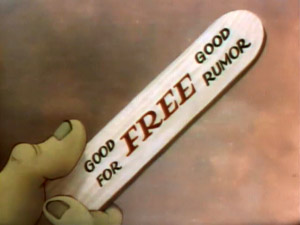 Bugs reappears, having acquired from whatever unknown prop and costime distributor supplies all animated characters a complete “Good Rumor” ice cream truck and ice cream man’s disguise. His truck is fully loaded with the day’s supplies – ice cream bars, which in x-ray view reveal a hand-grenade hidden inside. The precise means by which these are supposed to be activated is quite uncertain, as the grenade still has pin inserted at the top of the bar. Is it presumed the victim will chomp into the top of the bar, to remove the pin with his teeth? What if the soldier only licks the chocolate and ice cream away, without the pin being pulled? I guess a patriotic American is not supposed to concern himself about such details. Nevertheless, Bugs’ frachise is a great success among the newly-arrived troops, who all clamor to pay for Bugs’ product. In outright, and still to this day offensive, racial slurs, Bugs refers to his customers as “bow legs”, “monkey face”, and “slant eyes”. As Bugs’ product nearly sells out, we hear the sounds of explosions all over the island. Bugs is about to drive away, a job well done, when one surviving soldier, already with his outfit well blasted, returns, complaining, “Just one minute, Joe. You no get away from me. You waut.” Almost out of breath, he catches up to the truck, then displays the popsicle stick from inside his ice cream bar, inscribed with the promotional information that it is good for one more free bar. “Believe me, sweetie face, it’s a pleasure”, says Bugs, doubling the offer by handing the soldier a double-decker bar. “Hmm. Business is booming”, says Bugs, as two more explosions are heard in the distance.
Bugs reappears, having acquired from whatever unknown prop and costime distributor supplies all animated characters a complete “Good Rumor” ice cream truck and ice cream man’s disguise. His truck is fully loaded with the day’s supplies – ice cream bars, which in x-ray view reveal a hand-grenade hidden inside. The precise means by which these are supposed to be activated is quite uncertain, as the grenade still has pin inserted at the top of the bar. Is it presumed the victim will chomp into the top of the bar, to remove the pin with his teeth? What if the soldier only licks the chocolate and ice cream away, without the pin being pulled? I guess a patriotic American is not supposed to concern himself about such details. Nevertheless, Bugs’ frachise is a great success among the newly-arrived troops, who all clamor to pay for Bugs’ product. In outright, and still to this day offensive, racial slurs, Bugs refers to his customers as “bow legs”, “monkey face”, and “slant eyes”. As Bugs’ product nearly sells out, we hear the sounds of explosions all over the island. Bugs is about to drive away, a job well done, when one surviving soldier, already with his outfit well blasted, returns, complaining, “Just one minute, Joe. You no get away from me. You waut.” Almost out of breath, he catches up to the truck, then displays the popsicle stick from inside his ice cream bar, inscribed with the promotional information that it is good for one more free bar. “Believe me, sweetie face, it’s a pleasure”, says Bugs, doubling the offer by handing the soldier a double-decker bar. “Hmm. Business is booming”, says Bugs, as two more explosions are heard in the distance.
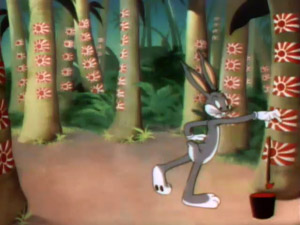 The final sequence finds Bugs having filled all of the island’s palm trees with flag insignia on his confirmed kills. (Quite a reputation to hold as the iconic star of a major studio.) He resumes his unfinished comment from the beginning of the picture about the peace and quiet of the island: “…and if there’s one thing I can’t stand, it’s PEACE ANF QUIET! I HATE IT!” With all the action gone, Bugs is completely frustrated, and throws a tantrum, calling for someone to get him out of this place. At that instant, an American destroyer passes the island at a distance. Bugs throws up a makeshift flag from one of the enemy’s shirts at the shoreline, hollering at the top of his lungs for the sailors to come and get him. But nobody seems to observe him. “Hey, shake it up. Step on it. Whatcha’ waitin’ for? Do ya think I wanna spend the rest of my life on this island?: Then, to his surprise, Bugs discovers he is not actually alone, as the digger of that mystery rabbit hole is revealed – a saronged female bunny with a flower pinned to one ear, who seductively suggests, “It’s a possibility.” Bugs lets out a wolf howl, lowers his signal flag, and pursues the gal across the island, now content that there is action here after all.
The final sequence finds Bugs having filled all of the island’s palm trees with flag insignia on his confirmed kills. (Quite a reputation to hold as the iconic star of a major studio.) He resumes his unfinished comment from the beginning of the picture about the peace and quiet of the island: “…and if there’s one thing I can’t stand, it’s PEACE ANF QUIET! I HATE IT!” With all the action gone, Bugs is completely frustrated, and throws a tantrum, calling for someone to get him out of this place. At that instant, an American destroyer passes the island at a distance. Bugs throws up a makeshift flag from one of the enemy’s shirts at the shoreline, hollering at the top of his lungs for the sailors to come and get him. But nobody seems to observe him. “Hey, shake it up. Step on it. Whatcha’ waitin’ for? Do ya think I wanna spend the rest of my life on this island?: Then, to his surprise, Bugs discovers he is not actually alone, as the digger of that mystery rabbit hole is revealed – a saronged female bunny with a flower pinned to one ear, who seductively suggests, “It’s a possibility.” Bugs lets out a wolf howl, lowers his signal flag, and pursues the gal across the island, now content that there is action here after all.
Here be an excerpt:
 Jungle Jive (Lantz/Universal, Swing Symphony, 5/15/44 – James (Shamus) Culhane, dir.) – A hot entry in this generally jazz-themed series of cartoons, which were something of the natural successors to the Fleischer personality cartoons of the Betty Boop series, centering action upon a lively musical performance (often with celebrity appearances). Starting with 1940’s “Scrub Me Mama With a Boogie Beat” (not yet bearing an official series title), Lantz wisely chose to apply the same style of Fleischer formula to more modern forms of swing and boogie woogie music – thus picking up where the now defunct Fleischer series left off. While Lantz’s animation did not approach the eccentricity of the New York artists, by the mid-40’s, particularly under the direction of Shamus Culhane, it was more than able to make up for this with pure spirit, truly “getting into the groove” of its subject matter with lively and active motion and frequently unique shot angles, staging, and minimalistic backgrounds nearly predicting the styles that would become UPA’s trademarks. This installment is a classy case in point, reflecting the best of the series’ trends on all counts.
Jungle Jive (Lantz/Universal, Swing Symphony, 5/15/44 – James (Shamus) Culhane, dir.) – A hot entry in this generally jazz-themed series of cartoons, which were something of the natural successors to the Fleischer personality cartoons of the Betty Boop series, centering action upon a lively musical performance (often with celebrity appearances). Starting with 1940’s “Scrub Me Mama With a Boogie Beat” (not yet bearing an official series title), Lantz wisely chose to apply the same style of Fleischer formula to more modern forms of swing and boogie woogie music – thus picking up where the now defunct Fleischer series left off. While Lantz’s animation did not approach the eccentricity of the New York artists, by the mid-40’s, particularly under the direction of Shamus Culhane, it was more than able to make up for this with pure spirit, truly “getting into the groove” of its subject matter with lively and active motion and frequently unique shot angles, staging, and minimalistic backgrounds nearly predicting the styles that would become UPA’s trademarks. This installment is a classy case in point, reflecting the best of the series’ trends on all counts.
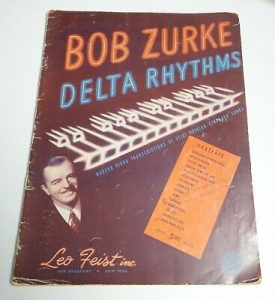 Guest artist for the session (receiving name credit on the titles) is pianist Bob Zurke. Perhaps not as well known as some of his contemporary counterparts, such as boogie artists Pete Johnson and Albert Ammons, stride virtuoso Fats Waller, and the like, Zurke was nevertheless a competent master of the boogie woogie rhythm, having worked his way up in the big band circuits from such orchestras as Bob Crosby (memorably duplicating in big band arrangement Meade Lux Lewis’s composition, “Honky Tonk Train Blues”, among other accomplishments). By 1939, he had his own band and a recording contract with Victor. But the elusive breakthrough hit side was not forthcoming, and economic pressures, alimony disputes, and alcohol dependency spelled the band’s demise by 1940, and an end to his recording contract. He continued to work jazz club circuits, and was somehow remembered by Lantz to bring him back into the limelight one final time for this performance. It would be his last recording, as he died an untimely death from pneumonia at age 32 on February 16, 1944 – never surviving to see the release of his only cartoon.
Guest artist for the session (receiving name credit on the titles) is pianist Bob Zurke. Perhaps not as well known as some of his contemporary counterparts, such as boogie artists Pete Johnson and Albert Ammons, stride virtuoso Fats Waller, and the like, Zurke was nevertheless a competent master of the boogie woogie rhythm, having worked his way up in the big band circuits from such orchestras as Bob Crosby (memorably duplicating in big band arrangement Meade Lux Lewis’s composition, “Honky Tonk Train Blues”, among other accomplishments). By 1939, he had his own band and a recording contract with Victor. But the elusive breakthrough hit side was not forthcoming, and economic pressures, alimony disputes, and alcohol dependency spelled the band’s demise by 1940, and an end to his recording contract. He continued to work jazz club circuits, and was somehow remembered by Lantz to bring him back into the limelight one final time for this performance. It would be his last recording, as he died an untimely death from pneumonia at age 32 on February 16, 1944 – never surviving to see the release of his only cartoon.
Culhane and the Lantz artists give him a fitting sendoff with this effort. Setting is in the tropical Sandwich Islands, featuring such obvious puns as islands loaded with Ham on Rye, Deviled Egg, Hot Dog on a Bun, Hamburger (with the inevitable “Hold the Onions” sign popularized by Friz Freleng), and the locale for our story, on the isle of Tunaville. We can only assume there is some cross-population of this village from Australia, as a running gag is provided by a young native training on the beach at a boomerang practice course. Predictably, every toss returns to conk him in the head. But this is not the center of our story. Another tribesman (it should be noted that, while skin tone of these locals is considerably lighter than a cannibal race, and no suggestion of such dietary tendencies is offered, character designs almost border on traditional black stereotypes, with prominent large lips on most characters – I guess it was what the artists were familiar with drawing, so they just modified the colors even when a black race was not the subject topic) acts as lookout atop a cocoanut palm, scanning the seas with a spyglass. He spots a curious sight unfamilar to the islanders – a large crate fallen overboard from some unknown vessel, its contents marked as “musical instruments”. The crate washes ashore and bursts open, spilling out enough articles to provision an entire big band. The lookout scurries down the tree, and sends a bulletin to the village via the latest thing in signal tom-toms – a drum equipped with typewriter keys attached to a series of mallets, with the drum itself attached to a sliding carriage complete with bell to signal the user when to return the carriage to starting position. The villagers arrive to inspect the strange devices spread over the beach. A first curious soul cautiously approaches a bass fiddle. Taking hold of one of the tuning pegs, he begins to turn it, tightening anf tightening the string until it snaps, winding itself in a coil around the native’s neck (another cross-over reference indicating the Lantz animators were more familiar with African natives than tropical ones). A small native struggles to pull out a slide trombone partially wedged in the sand, and falls backwards into the bell of a tuba. Another native helpfully blows his most powerful blow into the tuba mouthpiece to free the little guy, shooting him out the other end. Unfortunately, a second native is a bit too helpful, and tries to catch the little guy – between a pair of cymbals. CRASSSHHHHH!
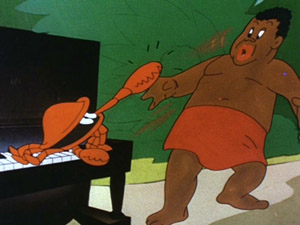 Now begins the real fun. A large fat native (likely intended to remind us of the already-late Fats Waller – another pneumonia victim) hears random notes emitting from an upright piano. He cautiously creeps up on the instrument from behind, peering around the sides to observe the keyboard. The musician responsible for the errant sounds is a large red crab who has washed up with the instruments. The crab’s design, although simplified by Culhane so that animators and ink and paint would only have to worry about two colors – a red shell and a black shin-interior – is a dead ringer for the design originated by Disney in “Hawaiian Holiday” reviewed earlier in this series – making liberal use of the upper shell as a hat to cock in a “tough guy” attitude to give the creature real personality. The crustacean is a musical natural, and trots his way up and down the keys, hammering out a relentless and fiery boogie-woogie beat (Zurke’s extended solo). Culhane wonderfully choreographs the critter’s motions as a veritable dance, making full use of both big and small claws flailing wildly, and wonderful angular slants and slides to emphasize motion and propel the character with a hypnotic effect that could make the viewer want to stay and watch him dance all day. A Baxter’s Breakdown column on this cartoon posted quite some time ago provided evidence that the crab animation was well distributed among most of the credited animators on the cartoon – so it is a credit to their coordinated efforts that the character animation maintains such consistent quality from shot to shot. The crab is at first resistant to the peering eyes and interfering hands of the fat native, who keeps attempting to join in the session, first in upper register, later on lower. The crab attempts several times to repel the intrusion with snaps of his claws that just miss their target – even one attempt to go for the native’s toes when the native briefly takes over the keyboard himself – but still fails to find his pinching mark, as the native stomps out a rhythm, driving the crab into the sand. But the crab will not be counted out, and has the final say by appearing on the keys again from out of the sound box of the instrument, taking over the high notes while the native continues to pound out bass rhythm, finally compromising as a successful duet, with the crab literally dancing himself into exhaustion with his exhilarating finish, stumbling to one side for his final climactic notes, and collapsing in a heap in a corner, one large claw dangling limply from its own weight as the creatures eyes maintain a dazed look.
Now begins the real fun. A large fat native (likely intended to remind us of the already-late Fats Waller – another pneumonia victim) hears random notes emitting from an upright piano. He cautiously creeps up on the instrument from behind, peering around the sides to observe the keyboard. The musician responsible for the errant sounds is a large red crab who has washed up with the instruments. The crab’s design, although simplified by Culhane so that animators and ink and paint would only have to worry about two colors – a red shell and a black shin-interior – is a dead ringer for the design originated by Disney in “Hawaiian Holiday” reviewed earlier in this series – making liberal use of the upper shell as a hat to cock in a “tough guy” attitude to give the creature real personality. The crustacean is a musical natural, and trots his way up and down the keys, hammering out a relentless and fiery boogie-woogie beat (Zurke’s extended solo). Culhane wonderfully choreographs the critter’s motions as a veritable dance, making full use of both big and small claws flailing wildly, and wonderful angular slants and slides to emphasize motion and propel the character with a hypnotic effect that could make the viewer want to stay and watch him dance all day. A Baxter’s Breakdown column on this cartoon posted quite some time ago provided evidence that the crab animation was well distributed among most of the credited animators on the cartoon – so it is a credit to their coordinated efforts that the character animation maintains such consistent quality from shot to shot. The crab is at first resistant to the peering eyes and interfering hands of the fat native, who keeps attempting to join in the session, first in upper register, later on lower. The crab attempts several times to repel the intrusion with snaps of his claws that just miss their target – even one attempt to go for the native’s toes when the native briefly takes over the keyboard himself – but still fails to find his pinching mark, as the native stomps out a rhythm, driving the crab into the sand. But the crab will not be counted out, and has the final say by appearing on the keys again from out of the sound box of the instrument, taking over the high notes while the native continues to pound out bass rhythm, finally compromising as a successful duet, with the crab literally dancing himself into exhaustion with his exhilarating finish, stumbling to one side for his final climactic notes, and collapsing in a heap in a corner, one large claw dangling limply from its own weight as the creatures eyes maintain a dazed look.
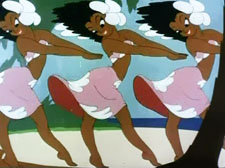 Now, the rest of the natives take up the remaining band instruments, and “go to town”. Not all of them quite know what they are doing – some blowing into the wrong end of their brass instruments, for example – but you’d never know there was a problem from the quality of Darryl Calker’s score. A trio of seductive female dancers perform a powerful hula with emphasized hip shifts. (While this may possibly have been too hot for the Kellogg’s program, the cartoon surprisingly went into later local syndication uncut, while other seductive counterparts as in “Abou Ben Boogie” and “The Greatest Man In Siam” remained off the airwaves.) A clarinet-playing native discovers a true zoological find, as a wave washes over him, replacing him with a clarinet playing alligator. (Never knew you could find them in the open sea,) A native playing the bass fiddle seems to get fine tone – curious, in that the wooden sound box springs open, revealing the inside packed with fish as tight as a sardine can. Finally, our boomerang afficionado closes the show, after getting clunked yet another time, by burying his entire collection of practice boomerangs in the sand, and joining the band instead – a move that doesn’t work out too well, as the buried boomerangs still find a way to return to their owner by popping out of the sand, conking him repeatedly and crashing him through most of the instruments, finally landing him under the piano with a cymbal on top of his head. The crab revives long enough to smash a final blow upon the cymbal with his claw, then raise both claws above his head to cheer himself as the victor, as the camera irises out.
Now, the rest of the natives take up the remaining band instruments, and “go to town”. Not all of them quite know what they are doing – some blowing into the wrong end of their brass instruments, for example – but you’d never know there was a problem from the quality of Darryl Calker’s score. A trio of seductive female dancers perform a powerful hula with emphasized hip shifts. (While this may possibly have been too hot for the Kellogg’s program, the cartoon surprisingly went into later local syndication uncut, while other seductive counterparts as in “Abou Ben Boogie” and “The Greatest Man In Siam” remained off the airwaves.) A clarinet-playing native discovers a true zoological find, as a wave washes over him, replacing him with a clarinet playing alligator. (Never knew you could find them in the open sea,) A native playing the bass fiddle seems to get fine tone – curious, in that the wooden sound box springs open, revealing the inside packed with fish as tight as a sardine can. Finally, our boomerang afficionado closes the show, after getting clunked yet another time, by burying his entire collection of practice boomerangs in the sand, and joining the band instead – a move that doesn’t work out too well, as the buried boomerangs still find a way to return to their owner by popping out of the sand, conking him repeatedly and crashing him through most of the instruments, finally landing him under the piano with a cymbal on top of his head. The crab revives long enough to smash a final blow upon the cymbal with his claw, then raise both claws above his head to cheer himself as the victor, as the camera irises out.
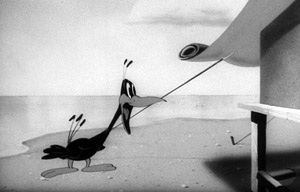 Outpost (Warner/Army-Navy Screen Magazine, Private Snafu. August, 1933 – Charles M. (Chuck) Jones, dir.) – On a microscopic island in an unknown portion of the Pacific, Snafu mans a lonely observation post, consisting only of a tent, a cot, and a radio receiver/transmitter. He is not quite alone, as he has taken it upon himself to “draft” into service a tropical bird, who he refers to as “Sad Sack” (Mel Blanc’s famous radio character on Armed Forces broadcasts), who does practically all of Snafu’s dirty work while the private himself loafs and snoozes away most of the day. Despite having no visible tasks to perform. Snafu is fed up with the solitude, and not being a part of the “scrap” his fellow soldiers are fighting. “249 days in this God-forsaken hole”, he complains, having counted the days in hash marks on the inside of his tent. We find this attitude of Snafu’s has obviously been in place ever since he got to the island, as a message comes in on the radio receiver that his “249th request for transfer has been denied.” Meanwhile, Sad Sack handles the actual work of scanning the horizon from the top of the island’s sole palm tree with a spyglass, punctuated with orders from Snafu to dispose of his cigarette butts (which the bird has buried in umpteen piles of sand on the beach, Snafu being a chronic chain smoker). Snafu dozes off to dreamland, and in a thought cloud envisions a curvaceous young thing I a bathing suit. The bird somehow sees Snafu’s cloud, and figures dreaming is a good idea for him too. The bird falls asleep in a split second next to Snafu, and dreams of his own image of beauty – a female bird, in the same type of bathing suit. The two dream clouds nearly converge, and, just for fun, the respective girls switch places in each other’s clouds. Snafu, at the sight of dreaming of a bird, is suddenly jarred awake, and fit to be tied. “That’s insubordination! I could break you for that!”, he tells the bird, then kicks his feathered friend out of the tent. Sad Sack lands in the sand at the shoreline, where he notices an opened can floating to the shore, with a partially-visible label reading “Pickled fish”. The bird dives into the water, eagerly retrieving the can as a possible meal – until he reads the whole description of its contents – “Pickled fish eyes with rice”. This unappetizing thought send shivers down Sad Sack’s spine, and he is about to dispose of the can, when he notices further writing on the bottom lid – “Hon. K Ration. Imperial Japanese Navy.” Realizing this may be important, Sad Sack zooms to Snafu. Snafu, however, is back in his dreams, now pursuing the bathing beauty across his dream cloud. Upset at being disturbed again, Snafy reads no further than the contents description, ignoring the can bottom, is again repelled by the product, and orders Sad Sack, “P.U.! Take this thing out and bury it.”
Outpost (Warner/Army-Navy Screen Magazine, Private Snafu. August, 1933 – Charles M. (Chuck) Jones, dir.) – On a microscopic island in an unknown portion of the Pacific, Snafu mans a lonely observation post, consisting only of a tent, a cot, and a radio receiver/transmitter. He is not quite alone, as he has taken it upon himself to “draft” into service a tropical bird, who he refers to as “Sad Sack” (Mel Blanc’s famous radio character on Armed Forces broadcasts), who does practically all of Snafu’s dirty work while the private himself loafs and snoozes away most of the day. Despite having no visible tasks to perform. Snafu is fed up with the solitude, and not being a part of the “scrap” his fellow soldiers are fighting. “249 days in this God-forsaken hole”, he complains, having counted the days in hash marks on the inside of his tent. We find this attitude of Snafu’s has obviously been in place ever since he got to the island, as a message comes in on the radio receiver that his “249th request for transfer has been denied.” Meanwhile, Sad Sack handles the actual work of scanning the horizon from the top of the island’s sole palm tree with a spyglass, punctuated with orders from Snafu to dispose of his cigarette butts (which the bird has buried in umpteen piles of sand on the beach, Snafu being a chronic chain smoker). Snafu dozes off to dreamland, and in a thought cloud envisions a curvaceous young thing I a bathing suit. The bird somehow sees Snafu’s cloud, and figures dreaming is a good idea for him too. The bird falls asleep in a split second next to Snafu, and dreams of his own image of beauty – a female bird, in the same type of bathing suit. The two dream clouds nearly converge, and, just for fun, the respective girls switch places in each other’s clouds. Snafu, at the sight of dreaming of a bird, is suddenly jarred awake, and fit to be tied. “That’s insubordination! I could break you for that!”, he tells the bird, then kicks his feathered friend out of the tent. Sad Sack lands in the sand at the shoreline, where he notices an opened can floating to the shore, with a partially-visible label reading “Pickled fish”. The bird dives into the water, eagerly retrieving the can as a possible meal – until he reads the whole description of its contents – “Pickled fish eyes with rice”. This unappetizing thought send shivers down Sad Sack’s spine, and he is about to dispose of the can, when he notices further writing on the bottom lid – “Hon. K Ration. Imperial Japanese Navy.” Realizing this may be important, Sad Sack zooms to Snafu. Snafu, however, is back in his dreams, now pursuing the bathing beauty across his dream cloud. Upset at being disturbed again, Snafy reads no further than the contents description, ignoring the can bottom, is again repelled by the product, and orders Sad Sack, “P.U.! Take this thing out and bury it.”
 At naval command central, a squad of top officers tracks the movements of the Japanese fleet past various observation checkpoints, but loses word on the fleet as their direction takes them into more remote waters, leaving no observation posts except Snafu’s. A bulletin is broadcast from HQ for all spotters to radio in a complete report of the day’s activities. Snafu is in no hurry. reacting with total boredom, and making remarks off microphone such as “Keep your shirt on”. When he finally flips on the microphone switch, he delivers in low key total sarcasm the “sensational events of the day” – such earth-shaking happenings as the sun coming up, the tide coming in and going out, and one drop of tropical rain. As an afterthought, he mentions the can of pickled fish eggs and rice, then signs off. The naval intelligence officers are instantly ignited at hearing mention of the can, and radio back for further complete details. Snafu thinks they must be nuts, but orders Sad Sack to retrieve the can. But Sad Sack can’t remember where he buried it, and mows down every sand pile of cigarette butts in vain search for the artifact. Hardly caring whether the hunt is successful or not, Snafu sarcastically remarks that maybe the bird swept it under the rug. Sad Sack brightens, and recalls that this is exactly what he did, literally lifting the edge of the sand at the shoreline, to reveal the can underneath. Snafu radios HQ, repeating the label’s inscription, but is signaled by the bird to look under the can, and finally communicates the reference to the Imperial Japanese Navy. With this information, a squad of fighter planes is launched from Allied carriers, and the Japanese fleet is bombed into a whirlpool closely resembling Paramount cartoons’ recurring gag of having Japanese ships sunk as if being flushed down a toilet. The film ends as the sun sets at the outpost island, Snafu tossing the can back into the sea, and sulking in complete non-recognition of what he has just accomplished. “I don’t get it. Wouldn’t you think they could find something important for me to do in this here army?” In exasperation at this remark, the sun itself collapses out of the sky, falling into the sea with a plop for a blackout ending.
At naval command central, a squad of top officers tracks the movements of the Japanese fleet past various observation checkpoints, but loses word on the fleet as their direction takes them into more remote waters, leaving no observation posts except Snafu’s. A bulletin is broadcast from HQ for all spotters to radio in a complete report of the day’s activities. Snafu is in no hurry. reacting with total boredom, and making remarks off microphone such as “Keep your shirt on”. When he finally flips on the microphone switch, he delivers in low key total sarcasm the “sensational events of the day” – such earth-shaking happenings as the sun coming up, the tide coming in and going out, and one drop of tropical rain. As an afterthought, he mentions the can of pickled fish eggs and rice, then signs off. The naval intelligence officers are instantly ignited at hearing mention of the can, and radio back for further complete details. Snafu thinks they must be nuts, but orders Sad Sack to retrieve the can. But Sad Sack can’t remember where he buried it, and mows down every sand pile of cigarette butts in vain search for the artifact. Hardly caring whether the hunt is successful or not, Snafu sarcastically remarks that maybe the bird swept it under the rug. Sad Sack brightens, and recalls that this is exactly what he did, literally lifting the edge of the sand at the shoreline, to reveal the can underneath. Snafu radios HQ, repeating the label’s inscription, but is signaled by the bird to look under the can, and finally communicates the reference to the Imperial Japanese Navy. With this information, a squad of fighter planes is launched from Allied carriers, and the Japanese fleet is bombed into a whirlpool closely resembling Paramount cartoons’ recurring gag of having Japanese ships sunk as if being flushed down a toilet. The film ends as the sun sets at the outpost island, Snafu tossing the can back into the sea, and sulking in complete non-recognition of what he has just accomplished. “I don’t get it. Wouldn’t you think they could find something important for me to do in this here army?” In exasperation at this remark, the sun itself collapses out of the sky, falling into the sea with a plop for a blackout ending.
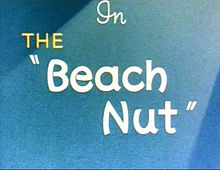 The Beach Nut (Lantz/Universal, Woody Woodpecker, 10/16/44 – James (Shamus) Culhane, dir.) – Culhane is at it again with his simplistic, stylized backgrounds, this time focusing on a beach in a metropolitan area. Who else except maybe Chuck Jones would portray nearly all beach exteriors with a combination of three unshaded solid colors – tan sand, dark blue water, and sky is a shade of solid orange, somewhere between vermillion and pumpkin pie? The film also stands as a landmark, introducing one of Woody’s most dependable and comical adversaries – the flustered and frustrated Swedish meatball, Wally Walrus.
The Beach Nut (Lantz/Universal, Woody Woodpecker, 10/16/44 – James (Shamus) Culhane, dir.) – Culhane is at it again with his simplistic, stylized backgrounds, this time focusing on a beach in a metropolitan area. Who else except maybe Chuck Jones would portray nearly all beach exteriors with a combination of three unshaded solid colors – tan sand, dark blue water, and sky is a shade of solid orange, somewhere between vermillion and pumpkin pie? The film also stands as a landmark, introducing one of Woody’s most dependable and comical adversaries – the flustered and frustrated Swedish meatball, Wally Walrus.
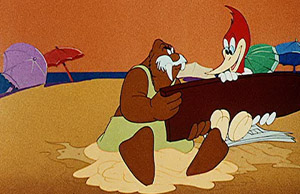 The film opens with a gag lifted from “Betty Boop’s Life Guard”, having all the bathers and beach umbrellas along the shoreline washed off the sand by one wave, then replaced in their original positions by another, while a narrator states “The soothing rhythm of the surf, shall we say, carries one away? Yes, I think we should.” But the real action is at the amusement pier, where a fight is in progress. Wally Walrus clutches Woody in one hand, and addresses the crowd. “I guess you think I’m trying to kill this turkey. Well, I am.” Wally tells the reasons why in flashback. As the morning begins, Wally, equipped with umbrella, chair, and picnic lunch, snoozes partially buried in the sand. Woody, carrying a surfboard, carelessly walks over him and steps on his face. Wally tosses the bird and board away, but no sooner has he set out his picnic lunch than Woody comes charging through again, flattening the walrus face first into a multi-layer cake. With a singing vocal assist by Lee Sweetland, Woody catches the waves while crooning “My Bonnie Lies Over the Ocean”, riding in on a crest and through Wally’s picnic again, this time picking up most of its contents. He comes to a stop in his own clear area, roasting Wally’s wieners over an open fire (despite warning sign directly behind him prohibiting fires on the beach). Wally meanwhile has been pushed face first into the sand, and, opening his eyelids, his eyeballs are transformed into the shape of two hourglasses with the sand trickling from top section to bottom section. Back at Woody’s camp, the fire isn’t burning so well, so Woody blows on it, producing clouds of smoke which drift and accumulate under the inner curve of Wally’s beach umbrella, burying the Walrus in a shower of smoke. Wally emerges from the cloud by literally opening a door in the side of the billowing puffs, then marches angrily to the woodpecker’s encampment. From out of the still drifting smoke clouds, Wally’s arms emerge to dump a bucket of water on the fire. Woody looks up in surprise, holding out his hand to test the weather for any more such freak rain showers. Despite the fact that his wood should still be considerably wet, Woody manages to restart the fire with one simple touch of a match, then carelessly tosses the match away – directly onto Wally’s beach umbrells, which is disintegrated into curled metal spokes. A single spark also falls onto Wally’s beach chair, burning it out from under him as well. To add insult to injury, Woody playfully appears in the hat of a fireman, and douses Wally in the face with a fire hose, complete with portable hydrant. Woody makes more unexpected appearances in the ensuing chase, including inside Wally’s trousers, replicating Wally’s every move as he ponders what to do next about the insane bird, then appearing again inside the bill of a roosting pelican, to deliver a series of his trademark pecks to Wally’s head.
The film opens with a gag lifted from “Betty Boop’s Life Guard”, having all the bathers and beach umbrellas along the shoreline washed off the sand by one wave, then replaced in their original positions by another, while a narrator states “The soothing rhythm of the surf, shall we say, carries one away? Yes, I think we should.” But the real action is at the amusement pier, where a fight is in progress. Wally Walrus clutches Woody in one hand, and addresses the crowd. “I guess you think I’m trying to kill this turkey. Well, I am.” Wally tells the reasons why in flashback. As the morning begins, Wally, equipped with umbrella, chair, and picnic lunch, snoozes partially buried in the sand. Woody, carrying a surfboard, carelessly walks over him and steps on his face. Wally tosses the bird and board away, but no sooner has he set out his picnic lunch than Woody comes charging through again, flattening the walrus face first into a multi-layer cake. With a singing vocal assist by Lee Sweetland, Woody catches the waves while crooning “My Bonnie Lies Over the Ocean”, riding in on a crest and through Wally’s picnic again, this time picking up most of its contents. He comes to a stop in his own clear area, roasting Wally’s wieners over an open fire (despite warning sign directly behind him prohibiting fires on the beach). Wally meanwhile has been pushed face first into the sand, and, opening his eyelids, his eyeballs are transformed into the shape of two hourglasses with the sand trickling from top section to bottom section. Back at Woody’s camp, the fire isn’t burning so well, so Woody blows on it, producing clouds of smoke which drift and accumulate under the inner curve of Wally’s beach umbrella, burying the Walrus in a shower of smoke. Wally emerges from the cloud by literally opening a door in the side of the billowing puffs, then marches angrily to the woodpecker’s encampment. From out of the still drifting smoke clouds, Wally’s arms emerge to dump a bucket of water on the fire. Woody looks up in surprise, holding out his hand to test the weather for any more such freak rain showers. Despite the fact that his wood should still be considerably wet, Woody manages to restart the fire with one simple touch of a match, then carelessly tosses the match away – directly onto Wally’s beach umbrells, which is disintegrated into curled metal spokes. A single spark also falls onto Wally’s beach chair, burning it out from under him as well. To add insult to injury, Woody playfully appears in the hat of a fireman, and douses Wally in the face with a fire hose, complete with portable hydrant. Woody makes more unexpected appearances in the ensuing chase, including inside Wally’s trousers, replicating Wally’s every move as he ponders what to do next about the insane bird, then appearing again inside the bill of a roosting pelican, to deliver a series of his trademark pecks to Wally’s head.
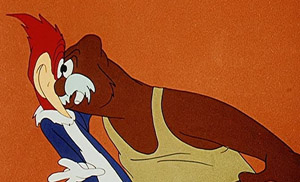 Wally pursues Woody onto the amusement pier. There he loses sight of the bird, but spots a booth proclaiming the fortune telling powers of Yogi Yoyo (Sees all, tells all – Palms read and greased – Missing woodpeckers located). Wally enters the darkened establishment (Culhane again resorting to color sumplicity by placing the characters and props against a backdrop of plain jet black). Ringing a signalling gong (mostly by walking into it), Wally summons the Yogi – Woody in disguise, somehow piloting a flying magic carpet. Woody buzzes Wally with a few high-speed aerial passes, then pulls out a telephone intercom as if on board a B-17 bomber, issuing to himself as all members of his one man crew the order, “Pilot to bombardier, bombardier to navigator, navigator to crew – prepare for crash landing. That is all. Roger.” He sets the carpet into a nose dive, pulling up an inch shy of Wally’s nose. Then a gloved mechanical hand on a telephone extender pulls the rumpled rug out from under Woody’s feet, landing hum neatly on the fortune teller’s table. “Fat boy wish to ask Yogi question?”, asks Woody. “Yah, yah. Where is that little redhead? Where did he go?”, demands Wally. “Hmm, that’s a toughie. Yogi must consult stars”, says Woody. The stars are easy to consult – once they emerge from a mallet blow to Wally’s head. What;s more, they produce an answer in a surprising manner – accumulating into the outline of a neon arrow, and the letters, “He’s in there.” The arrow points to a set of curtains decorated with shapes of a star and the moon. Wally instructs Woody to open the curtain while he grabs the bird. Woody obliges, not telling the walrus that there is a plate glass window concealed behind the curtain, which Wally crashes through. As Woody laughs, the hand of Wally renenters the room through the broken window, and Woody is yanked ourside – which is where we found the characters when the flashback began. “And that’s why I’m going to get rid of this woodpecker once and for good”, concludes Wally to the crowd, while harnessing Woody to a large anchor. With a mighty heave, Wally tosses the bird and anchor into the sea. However, he has not calculated two factors. One, the anchor rope is tied at its other end to a cleat on the dock. Two, the anchor is too heavy for the cleat to withstand the strain of the toss. The board to which the cleat is attached is pulled loose from the pier. The structural hole sets up a chain reaction, as plank by plank fall from the pilings of the pier. The spot where Wally is standing is undermined, and Wally falls into the sea, followed quickly by the entire spectator crowd. Somehow, Woody emerges from the water, rid of the weight ad entirely unscathed, to deliver his signature closing laugh, but is pursued in tail-away angle by a swimming Wally, followed by the entire crowd, for the iris out.
Wally pursues Woody onto the amusement pier. There he loses sight of the bird, but spots a booth proclaiming the fortune telling powers of Yogi Yoyo (Sees all, tells all – Palms read and greased – Missing woodpeckers located). Wally enters the darkened establishment (Culhane again resorting to color sumplicity by placing the characters and props against a backdrop of plain jet black). Ringing a signalling gong (mostly by walking into it), Wally summons the Yogi – Woody in disguise, somehow piloting a flying magic carpet. Woody buzzes Wally with a few high-speed aerial passes, then pulls out a telephone intercom as if on board a B-17 bomber, issuing to himself as all members of his one man crew the order, “Pilot to bombardier, bombardier to navigator, navigator to crew – prepare for crash landing. That is all. Roger.” He sets the carpet into a nose dive, pulling up an inch shy of Wally’s nose. Then a gloved mechanical hand on a telephone extender pulls the rumpled rug out from under Woody’s feet, landing hum neatly on the fortune teller’s table. “Fat boy wish to ask Yogi question?”, asks Woody. “Yah, yah. Where is that little redhead? Where did he go?”, demands Wally. “Hmm, that’s a toughie. Yogi must consult stars”, says Woody. The stars are easy to consult – once they emerge from a mallet blow to Wally’s head. What;s more, they produce an answer in a surprising manner – accumulating into the outline of a neon arrow, and the letters, “He’s in there.” The arrow points to a set of curtains decorated with shapes of a star and the moon. Wally instructs Woody to open the curtain while he grabs the bird. Woody obliges, not telling the walrus that there is a plate glass window concealed behind the curtain, which Wally crashes through. As Woody laughs, the hand of Wally renenters the room through the broken window, and Woody is yanked ourside – which is where we found the characters when the flashback began. “And that’s why I’m going to get rid of this woodpecker once and for good”, concludes Wally to the crowd, while harnessing Woody to a large anchor. With a mighty heave, Wally tosses the bird and anchor into the sea. However, he has not calculated two factors. One, the anchor rope is tied at its other end to a cleat on the dock. Two, the anchor is too heavy for the cleat to withstand the strain of the toss. The board to which the cleat is attached is pulled loose from the pier. The structural hole sets up a chain reaction, as plank by plank fall from the pilings of the pier. The spot where Wally is standing is undermined, and Wally falls into the sea, followed quickly by the entire spectator crowd. Somehow, Woody emerges from the water, rid of the weight ad entirely unscathed, to deliver his signature closing laugh, but is pursued in tail-away angle by a swimming Wally, followed by the entire crowd, for the iris out.
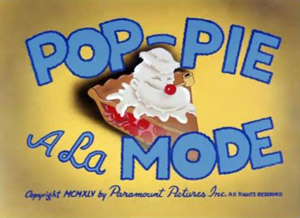 Pop-Pie A La Mode (Paramount/Famous, Popeye, 1/26/45 – I Sparber, dir.) – Isadore Sparber seemed to be Paramount’s go-to man when it came to anything to do with cannibals. He was responsible for three such epics in the studio’s history – this title, “Popeye’s Pappy”, which we encounter in a later chapter, and the infamous “Chew Chew Baby” with which he closed his career, which we recently reviewed in this column’s “Fitness v. Fatness” series. All of such episodes were frequently banned from television by most stations – until Ted Turner had the bravery to put the two Popeyes back into circulation. This one in particular deserved revival, as, in spite of its political incorrectness, it is loaded with genuinely funny gags, and an action-packed finish. In fact, the film was considered exceptional enough by the studio to cause an extended clip of the finale sequences to be included in the “cheater”, “Spinach v. Hamburgers” (1948), accounting for most TV prints of such film also being edited for content.
Pop-Pie A La Mode (Paramount/Famous, Popeye, 1/26/45 – I Sparber, dir.) – Isadore Sparber seemed to be Paramount’s go-to man when it came to anything to do with cannibals. He was responsible for three such epics in the studio’s history – this title, “Popeye’s Pappy”, which we encounter in a later chapter, and the infamous “Chew Chew Baby” with which he closed his career, which we recently reviewed in this column’s “Fitness v. Fatness” series. All of such episodes were frequently banned from television by most stations – until Ted Turner had the bravery to put the two Popeyes back into circulation. This one in particular deserved revival, as, in spite of its political incorrectness, it is loaded with genuinely funny gags, and an action-packed finish. In fact, the film was considered exceptional enough by the studio to cause an extended clip of the finale sequences to be included in the “cheater”, “Spinach v. Hamburgers” (1948), accounting for most TV prints of such film also being edited for content.
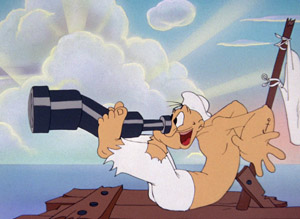 Our hero, despite all of his years of martime skills, has somehow wound up in the role of yet another castaway, with no indication whether his ship was scuttled by a storm or blasted out from under him by the Japanese. He drifts on a becalmed sea under the blazing sun, liberally applying sun tan lotion to soften the effects of the rays. “If I don’t get out of this hot Specific Ocean soon, I’ll look like poached Popeye on a raft.” At this convenient moment, a native passes Popeye’s raft on a paddleboat, wearing a “sandwich sign” style street advertisement, reading “If shipwrecked, try Joe’s – Reasonable rates.” “Avast, Avast! Some land at last!” Popeye shouts, pulling out his spyglass, and observing a nearby tropical island – complete with a multi-story luxury hotel (Joe’s Always Inn). Twirling his pipe in his mouth to use as an outboard motor, Popeye propels his vessel straight into the hotel lobby, and rings the desk bell for service. Through a small peephole in the wall, he is secretly observed by the proprietor Joe – a huge cannibal chief wearing a small top hat with a bone stuck through it. Joe’s voice bears a striking resemblance to Andrew H. Brown, from Freeman Gosden and Charles Correll’s famous “Amos ‘n’ Andy” radio show. Joe’s eyes pop at the sight of his new guest. “There’s a man to my taste…and I think he’ll agree with me,” he thinks aloud behind his wall. Visually, he views Popeye as transformed into a tender chop of raw meat. Turning the wall panel on a rotating center, Joe emerges into view, and announces he’ll be “happy to serve” the newcomer. He rings for two native bellboys to take care of their patron – “He is the specialty of the house.” As Popeye is ushered to his quarters to freshen up, Joe busies himself with a bit of refresher research, in a book entitled “How ro Serve Your Fellow Man” by Ima Cannibal. (An idea used over a decade before Rod Serling would convert the same trope into a punchline for an alien cookbook on the Twilight Zone in “To Serve Man”.) Joe realizes the first thing he has to do if he wants to maximize the yield from his new guest is to fatten him up. In a wildly grotesque series of scenes, Popeye, encouraged to not over-exert himself by being placed in a hammock between two palms, is nearly force-fed giant plates and bowls of the most fattening foods Joe’s kitchen can whip up, including mashed potatos, french fried potatoes, boiled spuds, baked Idahos, “more starch”, and massive calorie-filled cakes. The sailor, as he wipes his fingers clean in a finger bowl, begins to show some paunchiness around the waist, He does not notice a small native, the youngest of the tribe, who sneaks up quietly to the sailor’s leg extended out of the hammock, and fits it for size into a hamburger bun, adding a little mustard for flavor. Just before the little guy can put the bite on our hero, he is yanked away by the chief. “Ain’t I told you never to eat between meals?” the chief warns. Tossing the little one away, Joe approaches Popeye, and announces that he’s been “cooking up” a special event for the sailor – an initiation into the secret order of the Midnight Bath. Behind Joe’s back, he sharpens against each other a knife and fork, as the scene fades out.
Our hero, despite all of his years of martime skills, has somehow wound up in the role of yet another castaway, with no indication whether his ship was scuttled by a storm or blasted out from under him by the Japanese. He drifts on a becalmed sea under the blazing sun, liberally applying sun tan lotion to soften the effects of the rays. “If I don’t get out of this hot Specific Ocean soon, I’ll look like poached Popeye on a raft.” At this convenient moment, a native passes Popeye’s raft on a paddleboat, wearing a “sandwich sign” style street advertisement, reading “If shipwrecked, try Joe’s – Reasonable rates.” “Avast, Avast! Some land at last!” Popeye shouts, pulling out his spyglass, and observing a nearby tropical island – complete with a multi-story luxury hotel (Joe’s Always Inn). Twirling his pipe in his mouth to use as an outboard motor, Popeye propels his vessel straight into the hotel lobby, and rings the desk bell for service. Through a small peephole in the wall, he is secretly observed by the proprietor Joe – a huge cannibal chief wearing a small top hat with a bone stuck through it. Joe’s voice bears a striking resemblance to Andrew H. Brown, from Freeman Gosden and Charles Correll’s famous “Amos ‘n’ Andy” radio show. Joe’s eyes pop at the sight of his new guest. “There’s a man to my taste…and I think he’ll agree with me,” he thinks aloud behind his wall. Visually, he views Popeye as transformed into a tender chop of raw meat. Turning the wall panel on a rotating center, Joe emerges into view, and announces he’ll be “happy to serve” the newcomer. He rings for two native bellboys to take care of their patron – “He is the specialty of the house.” As Popeye is ushered to his quarters to freshen up, Joe busies himself with a bit of refresher research, in a book entitled “How ro Serve Your Fellow Man” by Ima Cannibal. (An idea used over a decade before Rod Serling would convert the same trope into a punchline for an alien cookbook on the Twilight Zone in “To Serve Man”.) Joe realizes the first thing he has to do if he wants to maximize the yield from his new guest is to fatten him up. In a wildly grotesque series of scenes, Popeye, encouraged to not over-exert himself by being placed in a hammock between two palms, is nearly force-fed giant plates and bowls of the most fattening foods Joe’s kitchen can whip up, including mashed potatos, french fried potatoes, boiled spuds, baked Idahos, “more starch”, and massive calorie-filled cakes. The sailor, as he wipes his fingers clean in a finger bowl, begins to show some paunchiness around the waist, He does not notice a small native, the youngest of the tribe, who sneaks up quietly to the sailor’s leg extended out of the hammock, and fits it for size into a hamburger bun, adding a little mustard for flavor. Just before the little guy can put the bite on our hero, he is yanked away by the chief. “Ain’t I told you never to eat between meals?” the chief warns. Tossing the little one away, Joe approaches Popeye, and announces that he’s been “cooking up” a special event for the sailor – an initiation into the secret order of the Midnight Bath. Behind Joe’s back, he sharpens against each other a knife and fork, as the scene fades out.
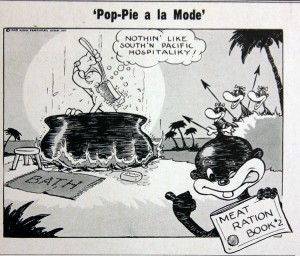 Act two takes place on the beach in the dark of night, as native tom-roms beat out a slow primitive rhythm. The whole tribe has turned out, around what appears to be a bathtub set in the open of a clearing. From behind a tree, Popeye shyly tiptoes out, dressed in a sarong, and approaches the bathtub for a public bathing. “Oh, this is embarrasskin. I ain’t done nothin’ like this since I lost a bet on Hoover.” He enters the tub, settling into the warm water. It’s going to get plenty warmer, as two natives quietly slip into the scene, and pull away the porcelain sides of the tub, separated into two halves. They are merely a fake front, and Popeye is actually resting in a cannibal cookpot inside, under which the natives quickly toss flaming logs to heat up the action, while the tom tom rhythms increase in intensity. Popeye begins to perspire, and pulls out of his sarong a small pocket fan to cool himself. Beside the pot enters the little native again, at first appearing innocent enough to have a halo around his head, but then showing his true nature by sprouting small devil horns. He produces his hamburger bun and mustard again, and finally gets a bite upon one of Popeye’s arms. “Yeow!”, shouts Popeye, finding the bun on his arm. “Hey, what kind of an initiation is this? You’d think these guys was cannibals.” A closer look at his audience reveals his instincts are more than correct, as all of them are now carrying at the ready their meat-rationing stamp books, the chief particularly loaded down with several of them, while the little native carries only one stamp, and a sign reading “I get the neck”. A native in a tree wearing a chef’s hat rings a dinner bell and shouts, “Come and get it.” The natives converge on the pot. Popeye socks off his assailants right and left, but they outnumber him, and manage to bind his arms in rope. Then, with a pair of large mallets, they pound atop his head, slowly compessing him into the shape of a thick flat steak (the illusion emphasized with the bright meat-red of Popeye’s sarong). He is placed into a frying pan, as several natives flip him over and over like a pancake, while singing “You take the high rib, and I’ll take the low rib, and I’ll get the white meat before ya.” One flip sends Popeye into an extended flight into the air.
Act two takes place on the beach in the dark of night, as native tom-roms beat out a slow primitive rhythm. The whole tribe has turned out, around what appears to be a bathtub set in the open of a clearing. From behind a tree, Popeye shyly tiptoes out, dressed in a sarong, and approaches the bathtub for a public bathing. “Oh, this is embarrasskin. I ain’t done nothin’ like this since I lost a bet on Hoover.” He enters the tub, settling into the warm water. It’s going to get plenty warmer, as two natives quietly slip into the scene, and pull away the porcelain sides of the tub, separated into two halves. They are merely a fake front, and Popeye is actually resting in a cannibal cookpot inside, under which the natives quickly toss flaming logs to heat up the action, while the tom tom rhythms increase in intensity. Popeye begins to perspire, and pulls out of his sarong a small pocket fan to cool himself. Beside the pot enters the little native again, at first appearing innocent enough to have a halo around his head, but then showing his true nature by sprouting small devil horns. He produces his hamburger bun and mustard again, and finally gets a bite upon one of Popeye’s arms. “Yeow!”, shouts Popeye, finding the bun on his arm. “Hey, what kind of an initiation is this? You’d think these guys was cannibals.” A closer look at his audience reveals his instincts are more than correct, as all of them are now carrying at the ready their meat-rationing stamp books, the chief particularly loaded down with several of them, while the little native carries only one stamp, and a sign reading “I get the neck”. A native in a tree wearing a chef’s hat rings a dinner bell and shouts, “Come and get it.” The natives converge on the pot. Popeye socks off his assailants right and left, but they outnumber him, and manage to bind his arms in rope. Then, with a pair of large mallets, they pound atop his head, slowly compessing him into the shape of a thick flat steak (the illusion emphasized with the bright meat-red of Popeye’s sarong). He is placed into a frying pan, as several natives flip him over and over like a pancake, while singing “You take the high rib, and I’ll take the low rib, and I’ll get the white meat before ya.” One flip sends Popeye into an extended flight into the air.
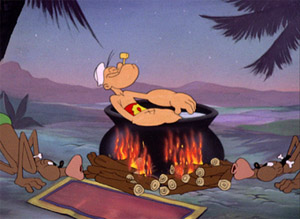 The force of the flip pops the sailor’s spinach can loose from his sarong. (Leave it to Popeye to even find a way to have a secret pocket built into this garment.) The can pops open (that was some flip) and pancake Popeye opens his mouth just wide enough to consume the falling spinach. Within moments, he is restored to his original shape, and then some – now muscular, slim and trim again, and beating on his chest as he lets out a Tarzan yell (portrayed in an interesting camera angle as our view disappears right down Popeye’s throat). Now, he really lays into the warriors, who approach with spears. In a twinkling, each spear is wound around its bearer like an iron coil, and each native tossed out of the fray with the spear poles neatly lined up in a row in the sand. Popeye begins taking up natives and spears one at time, and tossing them at Joe. In a lift of the spear-ladder gag from “Mickey’s Man Friday”, Joe climbs as the spears form a ladder up a tall palm tree, but climbs too high upon a few extra spears which exceed the height of the tree, causing him to fall to Earth. Joe bounces off several of the tom tom drums, right into Popeye’s fist. Knocked into the wall of the Inn, Joe retreats inside, resorting to an old gag which was a staple for Terrytoons – producing out of all the windows of the hotel an instant arsenal of cannon. In a feat of super strength, Popeye catches and collects all the cannon shells without exploding them – then compresses all the casings into one tremendous “block-buster” bomb. He then hurls the weapon back at the hotel, while his ear lobes curl into his ears to act as plugs against the noise of the forthcoming explosion. With a tremendous blast, Joe is jettisoned out of the hotel into the deep sea. As he rises to the surface, he is greeted by a pair of hungry sharks. But never underestimate the power of a hungry cannibal – all Joe sees in these adversaries is a new, fresh source of meat. Producing his knife and fork again, the tables quickly turn, and the sharks are put on the run, as carnivorous Joe madly paddles in quest of a fish fry after them. The final scene has Popeye now appointed new chief of the island, occupying a throne chair while the subservient tribe grovels in the chant of “Salami, Salami, Baloney.” (A verbal gag lifted from Fleischer’s “Aladdin and his Wonderful Lamp” (1939), and which we will encounter again later in this series.) Perhaps not everybody has learned to live in peace with the sailor, as a bite on the leg reveals painfully that the little native has still not lost his hamburger bun and mustard jar, as he delivers his only line of dialogue as a curtain line – a quote from the ‘Beulah” domestic character from the “Fibber McGee and Molly” radio show, of her catch-phrase, “I loves that man.”
The force of the flip pops the sailor’s spinach can loose from his sarong. (Leave it to Popeye to even find a way to have a secret pocket built into this garment.) The can pops open (that was some flip) and pancake Popeye opens his mouth just wide enough to consume the falling spinach. Within moments, he is restored to his original shape, and then some – now muscular, slim and trim again, and beating on his chest as he lets out a Tarzan yell (portrayed in an interesting camera angle as our view disappears right down Popeye’s throat). Now, he really lays into the warriors, who approach with spears. In a twinkling, each spear is wound around its bearer like an iron coil, and each native tossed out of the fray with the spear poles neatly lined up in a row in the sand. Popeye begins taking up natives and spears one at time, and tossing them at Joe. In a lift of the spear-ladder gag from “Mickey’s Man Friday”, Joe climbs as the spears form a ladder up a tall palm tree, but climbs too high upon a few extra spears which exceed the height of the tree, causing him to fall to Earth. Joe bounces off several of the tom tom drums, right into Popeye’s fist. Knocked into the wall of the Inn, Joe retreats inside, resorting to an old gag which was a staple for Terrytoons – producing out of all the windows of the hotel an instant arsenal of cannon. In a feat of super strength, Popeye catches and collects all the cannon shells without exploding them – then compresses all the casings into one tremendous “block-buster” bomb. He then hurls the weapon back at the hotel, while his ear lobes curl into his ears to act as plugs against the noise of the forthcoming explosion. With a tremendous blast, Joe is jettisoned out of the hotel into the deep sea. As he rises to the surface, he is greeted by a pair of hungry sharks. But never underestimate the power of a hungry cannibal – all Joe sees in these adversaries is a new, fresh source of meat. Producing his knife and fork again, the tables quickly turn, and the sharks are put on the run, as carnivorous Joe madly paddles in quest of a fish fry after them. The final scene has Popeye now appointed new chief of the island, occupying a throne chair while the subservient tribe grovels in the chant of “Salami, Salami, Baloney.” (A verbal gag lifted from Fleischer’s “Aladdin and his Wonderful Lamp” (1939), and which we will encounter again later in this series.) Perhaps not everybody has learned to live in peace with the sailor, as a bite on the leg reveals painfully that the little native has still not lost his hamburger bun and mustard jar, as he delivers his only line of dialogue as a curtain line – a quote from the ‘Beulah” domestic character from the “Fibber McGee and Molly” radio show, of her catch-phrase, “I loves that man.”
NEXT WEEK: More 40’s sun and tropics.


 Charles Gardner is an animation enthusiast who toils by day as a member of LA Law – but by nights and weekends indulges in classic jazz and ragtime as a performer; and studies classic Hollywood cartoons… maybe a little too much.
Charles Gardner is an animation enthusiast who toils by day as a member of LA Law – but by nights and weekends indulges in classic jazz and ragtime as a performer; and studies classic Hollywood cartoons… maybe a little too much.


































































































































































Quite a lot of outrageous ethnic caricatures in this week’s selection of cartoons, from hypertrophic-lipped cannibals to squint-eyed, buck-toothed Japanese to big dumb Swedish walruses. When I was first getting acquainted with Popeye cartoons in the 1970s, “Pop-Pie a la Mode” wasn’t shown in the syndication package, but clips of it could be seen in the cheater “Hamburgers vs. Spinach”. I was intrigued by these images and began to wonder what other shameful vestiges of the past might have been, to borrow a metaphor from Private Snafu, swept under the rug.
The “Wackiki Wabbit” subtitle “Ofa eno maua te ofe popaa” looks as though it might be an authentic Polynesian phrase (but not Hawaiian, which lacks the F sound). Google Translate says it’s Samoan for “We have six popcorn.” However, when I tried to translate “We have six popcorn” into Samoan, it yielded something else.
The reptilian clarinetist in “Jungle Jive” would have to be, not an alligator, but a saltwater crocodile, the world’s largest living reptile. Alligators are only found in the southeastern U.S., with a smaller species endemic to China. Saltwater crocs, on the other hand, occur from India to Micronesia and all points in between. They commonly swim long distances in the open ocean and as such have been spotted far outside their normal range, for example in the Sea of Japan. Since they’re very abundant in northern Australia, perhaps that also explains how that boomerang got to the Sandwich Islands.
Thanks for the background on Bob Zurke. I’m always interested in any information on the musicians who lent their talents to these old cartoons.
“Wackiki Wabbitt” – The castaways are caricatures of Michael Maltese and Ted Pierce.
I just found and watched a complete download of “Bugs Bunny Nips the Nips”, though with poor picture quality. During the war few Americans would have known about the Japanese paper-folding art of origami, which would have made for a more clever and appropriate gag than the worn-out cliché of a wrestler tying his opponent into knots. But the weirdest thing about that cartoon, to my mind at least, is that the carillon in the “Good Rumor” truck, rather than playing an ice cream truck standard like “Turkey in the Straw” or “Greensleeves”, plays Papageno’s aria “Ein Vogelfaenger bin ich ja” from Act I of “The Magic Flute” by Mozart. Some German opera to go with your pretzel, I suppose.
Re “Wackiki Wabbit:” The scene of the two castaways hallucinating each other as food is reminiscent of the scene in Charlie Chaplin’s “The Gold Rush” (1925), in which Charlie and Mack Swain are snowbound in an isolated cabin, out of food, and Swain begins to hallucinate that Charlie is giant chicken, and tries to eat him.
Somehow Popeye, dressed in rags when we first see him, manages to find his full sailor outfit (around the 3 min mark).
The new outfit would have been provided by Joe as a courtesy to his guest. “Hmm, looks like you could use some ‘dressing’!”
“A Hollywood Detour” (Columbia/Mintz, Color Rhapsodies, 24/1/42 — Frank Tashlin, dir.) takes a detour to Malibu Beach for a look at some of the same celebrities, and gags, previously seen in “Malibu Beach Party”. “Here, basking in the sun, are your favourites, old and new.” As the camera pans along the beach we see Laurel and Hardy, Clark Gable, and finally a shapely woman sauntering in a red swimsuit, her face concealed by a parasol. “Ah, she must be one of those lovely Hollywood starlets!” says the narrator. “Boy, isn’t she gorgeous! Mm-mm! I wonder who she is?” Then, as she turns to face the camera, we see that she’s… Edna Mae Oliver! Yikes!
Next we have a look at the local watercraft: boats, canoes, and a Raft (George, that is, flipping his trademark coin). Then majestic music plays, and who should emerge from the surf, wearing an old-fashioned striped bathing costume, but John Barrymore, his head turned at an angle to highlight his celebrated profile. A crowd of autograph-seekers, who had already mobbed him twice before in this cartoon, take the opportunity to do so again. But this time, Barrymore is ready for them. He whips out a Tommy gun and starts blasting away until Malibu Beach is littered with corpses, then lets out a Tarzan yell of triumph. At the end of the cartoon the autograph hounds, now adorned with halos, are standing at the Pearly Gates, waiting patiently for their favourite stars to arrive.
In 1945 the U.S. Navy commissioned Hugh Harman Productions to make a series of educational cartoons focusing on health issues for military personnel stationed in the Pacific. They feature Marine Private McGillicuddy, sort of a low-budget Private Snafu, who always does the wrong thing and later suffers for it. The fourth of these cartoons (seven have survived), “Native Foods”, belongs in this Animation Trail, as the narrator describes the island-bound Marine as “a gastronomical Robinson Crusoe.”
McGillicuddy longs to sample the local produce, but because of the natives’ slovenly personal habits, it gives him dysentery. Therefore all active duty personnel in the South Pacific are urged to avoid fresh fruits and vegetables in favour of wholesome canned military rations — here, a “Vienna sausage” that whinnies as the orchestra plays “The Old Grey Mare”.
Modern medical opinion, of course, is squarely against this advice. Even on Captain Cook’s voyages in the Pacific in the eighteenth century, he always had his men gather fresh food whenever they came ashore as an antidote to scurvy. That is, until his last port of call in Hawaii, where the local cuisine turned out to be — Captain Cook!